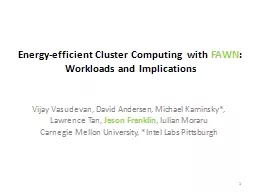PPT-Space-Efficient Data Structures for Top-k Completion
Author : cheryl-pisano | Published Date : 2015-11-11
Giuseppe Ottaviano Università di Pisa BoJune Paul Hsu Microsoft Research WWW 2013 String autocompletion Scored string sets Topk Completion query Given prefix p
Presentation Embed Code
Download Presentation
Download Presentation The PPT/PDF document "Space-Efficient Data Structures for Top-..." is the property of its rightful owner. Permission is granted to download and print the materials on this website for personal, non-commercial use only, and to display it on your personal computer provided you do not modify the materials and that you retain all copyright notices contained in the materials. By downloading content from our website, you accept the terms of this agreement.
Space-Efficient Data Structures for Top-k Completion: Transcript
Download Rules Of Document
"Space-Efficient Data Structures for Top-k Completion"The content belongs to its owner. You may download and print it for personal use, without modification, and keep all copyright notices. By downloading, you agree to these terms.
Related Documents














